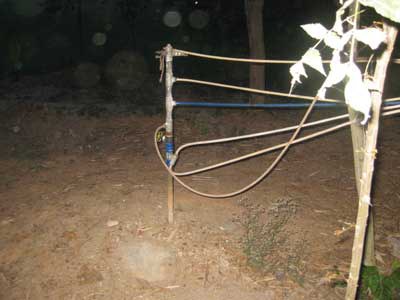Use of poultry litter to run bio-gas plants – Case study of Rajan Sen, Village Lagata, District Gazipur, Bangladesh
Mar 17, 2010
Rajan Sen, a resident of Lagata village in the Gazipur district of Bangladesh, lives with his wife Jaya and two sons in a pucca house. Rajan owns 2 cows and 4 acres of land and runs a grocery shop in the village. Until 2008, he also owned a poultry farm with 1,000 birds. In 2005, on learning about BASA’s1 interventions of supporting the setting up of bio-gas plants using poultry litter, he approached BASA. The total investment required to set up a bio-gas plant of 4.8 cubic metres ranged between 25,000-30,000 Taka, of which 7000-8000 Taka was provided as subsidy by the Government. The bio-gas plant ran very well and produced enough cooking gas for Rajan to lease out nine connections to nearby households, in addition to his own.
In 2008 Rajan lost his entire poultry flock to bird flu and did not have any litter to run the bio-gas plant. He was apprehensive to re-start the poultry business again. In order to ensure that his bio-gas plant continued to function, Rajan decided to purchase poultry litter from poultry rearing households within his village and neighbouring villages. He purchases an average of 80 litres of poultry litter daily costing 40-50 taka, to run his bio-gas plant. The poultry litter is transported to the bio-gas plant site by Rajan using his cycle-rickshaw. Poultry rearers in the vicinity are happy to sell off the poultry litter which is not otherwise directly used, as compared to cow-dung which is a valuable farm-yard manure.
Rajan informed that although earlier, when he had his own poultry farm he had provided nine connections, but now, since he has to purchase poultry litter, he can provide a constant supply of cooking gas to six households including his own. Each of the six households owns a single burner and gas supplied is enough to take care of their needs. “Since the gas supply is available round the clock, even a tea-stall close by uses the bio-gas connection provided by me”, informs Rajan proudly.
 The slurry produced from the biogas plant is purchased by the Institute of Soil Science, at the rate of 2000 Taka every six months. Rajan’s wife Jaya shared that prior to the installation of the bio-gas plant she used to cook on a chulha2 for which she had to collect firewood on a daily basis. She informed that cooking on a chulha produced a lot of smoke and soot which resulted in constant coughing and other related health problems for both herself and her children. It is much more comfortable to now cook on a single burner cook stove that uses bio-gas. Cooking is also faster since the intensity of the flame is high. The use of bio-gas has also considerably reduced her work load in collecting fuel wood.
The slurry produced from the biogas plant is purchased by the Institute of Soil Science, at the rate of 2000 Taka every six months. Rajan’s wife Jaya shared that prior to the installation of the bio-gas plant she used to cook on a chulha2 for which she had to collect firewood on a daily basis. She informed that cooking on a chulha produced a lot of smoke and soot which resulted in constant coughing and other related health problems for both herself and her children. It is much more comfortable to now cook on a single burner cook stove that uses bio-gas. Cooking is also faster since the intensity of the flame is high. The use of bio-gas has also considerably reduced her work load in collecting fuel wood.
Rajan shares that in his view, the setting up of a poultry litter based bio-gas plant was a wise move since inspite of the loss of his poultry birds there were enough resources around to ensure a regular supply of poultry litter for the plant. Leasing out five connections ensures a regular income of 2500 Taka each month, apart from the income from the sale of slurry of 2000 Taka once every six months. Learning from his example, other households in the vicinity have similarly set up poultry litter based bio-gas plants, irrespective of whether they own poultry flocks.
References:
1 Bangladesh Association for Social Advancement
2 Stove made of mud and bricks
Contributed by - SA PPLPP Coordination Team



